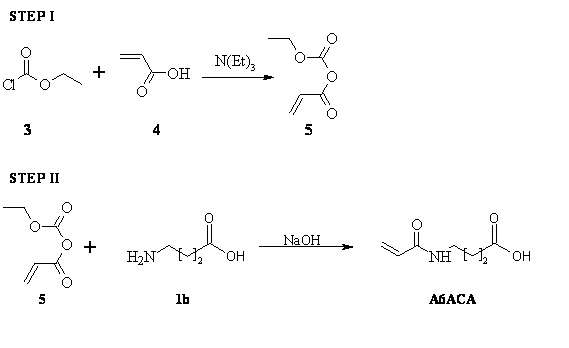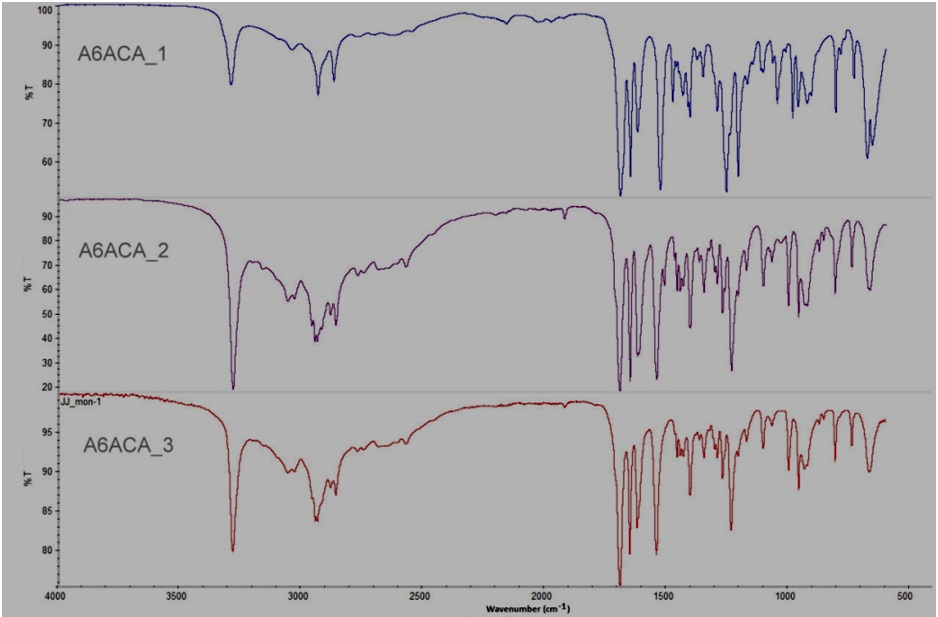Recently, there is a growing need in application of hydrogel materials in biomedicine, nanotechnology, tissue engineering, and both medicine and pharmacy. Moreover, the latest literature reports describe great tendency of development and application of self healing hydrogels[1]-[3]]. Self regenerative or self healing materials possess the ability to repair themselves after damage that could extend the applications of such materials. However, sometimes the self healing process must be induced by external factors such as temperature, pH or light and hence the materials are defined as non automatic self regenerative systems[4]. Very interesting group of materials constitute acryloyl derivatives of aminoacids, because they contain hydrophobic alkyl chain (length 1/4n) and hydrophilic carboxylic groups. Hence, the syntheses of self healing hydrogels based on N acryloyl aminocaproic acid A6ACA were performed[5].
Formation of A6ACA monomers involves interaction of previously synthesized anhydride (5) with 6-aminocaproic acid (1b). Anhydride (5) can be obtained in the reaction of ethyl chloroformate (3) with acrylic acid (4). The scheme 1 exemplify formation of A6ACA monomers.

Fig.1. Synthesis of A6ACA from acryloyl ethyl carbonate (5) and 6-aminocaproic acid (1b).
The monomers were received at variable temperatures: of (1)-25 °C , (2)-78 °C and (3)-82 °C respectively and were analyzed by means of FT-IR.

Fig.2. FT-IR spectra of A6ACA monomers received at various experimental conditions.
Additionally, the solution that contained A6ACA monomers was enriched in supportive substance such as guar gum, that improved mechanical properties of attained hydrogels. The guar gum possesses the ability to stabilize, thickening, gelling and therefore is extensively applied in pharmacology.
Received hydrogel materials were subjected to measurements of swelling ability and incubation studies in distilled water, simulated body fluids (SBF at pH=7.4) and Ringer's fluids (pH=5-7.50). Moreover the structure of formed hydrogels enriched with guar gum was analyzed by means of FT-IR and morphology was visualized using SEM equipped with EDS.
This research was financially supported by Grant no 0489/IP3/2015/73.
References:
[1] V. Amendola, M. Meneghetti Nanoscale 2009;1:74-88.
[2] Haoqun Hong, Haiyang Liao,Shujia Chen , Haiyan Zhang, Materials Letters 122 (2014) 227–229.
[3] Mohamadreza Nassajian Moghadam, Vitaliy Kolesov, Arne Vogel, Harm-Anton Klok, Dominique P. Pioletti, Biomaterials 35 (2014) 450-455
[4] S. K. Ghosh, Self-healing Materials: Fundamentals, Design Strategies, and Applications, Wiley-VCH, Weinheim, 2008.
[5] Ameya Phadke, Chao Zhang, Bedri Arman, Cheng-Chih Hsu, Raghunath A. Mashelkar, Ashish K. Lele, Michael J. Tauber, Gaurav Arya, Shyni Varghese, Rapid self-healing hydrogels, Proceedings of the National Academy of Sciences, 2012, 109 (12), 4383–4388.